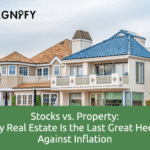The multifamily investment world has completely changed in 2025. Remember when you could get a loan at 3% interest? Those days are gone, and smart investors are scrambling to figure out what works now.
Here’s the reality: what made money two years ago might lose money today. The old playbook doesn’t work when borrowing costs have doubled, and many investors are learning this lesson the hard way. But here’s the good news – there are still profitable deals out there if you know how to find and evaluate them properly.
The key is understanding when to target stable, lower-return core properties versus higher-risk, higher-reward value-add opportunities. Both can work in today’s market, but the approach to evaluating each has fundamentally changed.
When most investors learned to buy investment property, they were working in a completely different environment. Low interest rates made almost any deal look profitable on paper.
Today’s reality is harsh but simple: higher borrowing costs mean lower returns across the board. What used to generate 15% returns might now struggle to hit 8%. This isn’t necessarily bad – it just means you need to be smarter about deal selection and more realistic about expectations.
Many investors are still using outdated assumptions in their analysis:
These mistakes can turn what looks like a great deal into a cash flow disaster. Success in 2025 requires completely rethinking your approach to property evaluation.
Core properties are the steady performers of the multifamily world. Think of well-maintained apartment buildings in good neighborhoods with long-term tenants already paying market rents. These aren’t exciting investments, but they’re predictable.
Core properties typically feature:
In uncertain economic times, predictability becomes valuable. Core properties offer several advantages in today’s market:
The main drawback of core properties is limited upside potential. You’re essentially buying a bond that pays rent instead of interest. In an inflationary environment, this can be problematic if rent increases don’t keep pace with rising expenses.
Additionally, competition for quality core properties remains fierce among institutional investors, often driving prices to levels that barely justify the returns.
Value-add properties are the fixer-uppers of the multifamily world. These are properties where you can increase value through renovations, better management, or operational improvements.
Common value-add strategies include:
Despite higher interest rates, value-add properties offer unique advantages:
The most important change in underwriting is becoming more conservative with projections. This means:
Every deal should survive worst-case scenarios. Ask yourself:
If your deal doesn’t survive these stress tests, it’s probably not worth the risk.
The choice between primary and secondary markets has become more critical in high-rate environments.
Primary Markets (like those focused on Multifamily Investments in Bay Area Real Estate offer stability but at premium prices. These markets typically have:
Secondary Markets often provide better value with decent growth potential:
Market timing matters more in high-rate environments. Working with experienced real estate investment firms can help identify optimal entry points.
Current indicators suggest the market is transitioning, with some experts predicting rate stabilization in late 2025. This could create opportunities for well-positioned investors.
Your financing choice can make or break a deal:
By leveraging these technological tools, investors can focus on high-potential deals, shorten acquisition timelines, and increase the likelihood of achieving high-ROI deals in competitive markets.
Lower leverage is your friend in high-rate markets. Consider:
The choice between core and value-add ultimately comes down to your risk tolerance and investment goals:
Many successful investors combine both strategies, using core properties for steady income and value-add deals for growth potential. This balanced approach can provide both stability and upside potential.
The opportunities for profitable multifamily investment in 2025 still exist, but they require a different approach than previous years.
Success comes from:
The investors who adapt to this new reality – focusing on quality deals with conservative projections – will find opportunities while others struggle with outdated strategies.
Should I avoid multifamily investing because of high interest rates?
No, but you need to be more selective. High interest rates eliminate marginal deals but don’t prevent good investments. Focus on properties with strong fundamentals and conservative projections.
Which is better in 2025: core or value-add properties?
It depends on your situation. Core properties offer more predictable returns, while value-add can provide higher returns if executed properly. Many successful investors use both strategies.
How much should I budget for renovations on value-add properties?
Budget 20-30% more than pre-2023 costs due to inflation. Always include contingency funds and expect projects to take longer than planned.
What markets offer the best opportunities right now?
Secondary markets with population growth and business-friendly environments often provide the best risk-adjusted returns. Avoid markets with excessive new construction or declining populations.
How long should I plan to hold properties in this market?
Longer hold periods are generally better in high-rate environments. Plan for 5-7 years minimum to ride out interest rate cycles and maximize value creation.
The multifamily investment landscape has changed, but opportunities remain for investors who adapt their strategies. Whether you choose core properties for stability or value-add for growth potential, success requires conservative underwriting, realistic expectations, and patience.
The key is matching your investment strategy to your risk tolerance and market expertise while maintaining the discipline to wait for deals that make sense in today’s environment. The investors who master this approach will thrive while others struggle with outdated strategies.
Ready to succeed in today’s challenging market conditions? Focus on quality deals with conservative assumptions and partner with experienced professionals who understand the current landscape.





